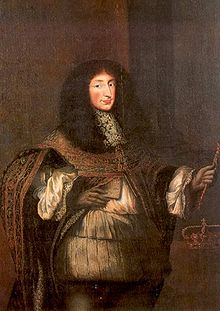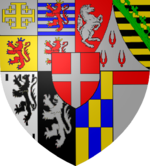- Charles Emmanuel II, Duke of Savoy
-
Charles Emmanuel II 
Duke of Savoy Reign 4 October 1638 – 12 June 1675 Predecessor Francis Hyacinth Successor Victor Amadeus II Regent Christine Marie of France Spouse Françoise Madeleine d'Orléans
Marie Jeanne of SavoyIssue Victor Amadeus II of Savoy Full name Carlo Emanuele di Savoia House House of Savoy Father Victor Amadeus I, Duke of Savoy Mother Christine Marie of France Born 20 June 1634
Turin, ItalyDied 12 June 1675 (aged 40)
Turin, ItalyReligion Roman Catholicism Charles Emmanuel II (Italian: Carlo Emanuele II di Savoia) (20 June 1634 – 12 June 1675) was the Duke of Savoy from 1638 to 1675 and under regency of his mother Christine Marie of France until 1663. He was also Marquis of Saluzzo, Count of Aosta, Geneva, Moriana and Nice, as well as claimant king of Cyprus and Jerusalem. At his death in 1675 his second wife Marie Jeanne of Savoy acted as Regent for their eleven year old son.
Contents
Biography
He was born in Turin to Victor Amadeus I, Duke of Savoy and Christine Marie of France. His maternal grandparents were Henry IV of France and his second wife Marie de' Medici. In 1638 at the death of his older brother Francis Hyacinth, Duke of Savoy, Charles Emmanuel succeeded to the duchy of Savoy at the age of 4. His mother governed in his place, and even after reaching adulthood, Charles Emmanuel continued a life of pleasure, far away from the affairs of state.
He became notorious for his persecution of the Vaudois (Waldensians) culminating in the massacre of 1655. The massacre was so brutal that it prompted the English poet John Milton to write the sonnet On the Late Massacre in Piedmont. Lord Protector Oliver Cromwell called for a general fast in England and proposed to send the British Navy if the massacre was not stopped while gathering funds for helping the Waldensians. Sir Samuel Morland was commissioned with that task. He later wrote The History of the Evangelical Churches of the Valleys of Piemont (1658).
Only after the death of his mother in 1663, did he really assume power. He was not successful in gaining a passage to the sea at the expense of Genoa (Second Genoese-Savoyard War, 1672–1673), and had difficulties in retaining the influence of his powerful neighbour France.
But he greatly improved commerce and wealth in the Duchy, developing the port of Nice and building a road through the Alps towards France. He also reformed the army, which until then was mostly composed of mercenaries: he formed instead five Piedmontese regiments and recreated cavalry, as well as introducing uniforms. He also restored fortifications. He constructed many beautiful buildings in Turin, for instance the Palazzo Reale. He is buried at Turin Cathedral.
Marriage
Charles Emmanuel married twice.
- 1. Françoise Madeleine d'Orléans (b.1648-d.1664), daughter of his maternal uncle Gaston, Duke of Orléans and younger brother of his mother Christine Marie. The couple had no issue;
- 2. Marie Jeanne of Savoy (1644-1724) had issue; was created regent of Savoy in 1675; regency ended in 1680 but Marie Jeanne maintained power till 1684;
Issue
- Victor Amadeus II of Savoy, future King of Sicily and later Sardinia; married Anne Marie d'Orléans and had issue; had illegitimate issue also; married Anna Teresa Canalis di Cumania in a morganatic marriage;
- Charles Emmanuel II also had a number of illegitimate children.
Ancestors
References
Titles and styles
- 20 June 1634 – 4 October 1638 His Highness Prince Charles Emmanuel of Savoy
- 4 October 1638 – 12 June 1675 His Highness the Duke of Savoy
See also
1st Generation none2nd Generation Prince Anthony · Prince Anthony · Louis, Duke of Savoy · Amadeus, Prince of Piemont · Philip, Prince of Achaea3rd Generation Amadeus, Duke of Savoy · Louis, Count of Geneva · Prince Giovanni · Philip, Duke of Savoy · Giano, Count of Faucigny and Geneva · Pietro, Bishop of Geneva · Prince Aimone · Prince Giacomo · Giovanni Ludovico, Bishop of Geneva · Jacques, Count of Romont4th Generation Prince Luigi · Carlo, Prince of Piedmont · Philibert, Duke of Savoy · Prince Bernardo · Charles, Duke of Savoy · James Louis, Count of Genevois · Prince Gian Claudio Galeazzo · Prince Girolamo · Philibert, Duke of Savoy · Charles, Duke of Savoy · Prince Louis · Philippe, Duke of Nemours · Prince Assolone · Prince Giovanni Amedeo · Prince Emanuele Filiberto Adriano · Prince Louis · Emmanuel Philibert, Duke of Savoy5th Generation Charles Emmanuel I, Duke of Savoy · Jacques, Duke of Nemours6th Generation Filippo Emanuele, Prince of Piedmont · Victor Amadeus I, Duke of Savoy · Charles Emmanuel, Duke of Nemours · Henri, Prince de Genevois · Prince Louis · Prince François Paul · Henri, Duke of Nemours · Thomas Francis, Prince of Carignano · Maurice, Cardinal of Savoy · Prince Emmanuel Filibert7th Generation Prince Louis Amadeus · Francis Hyacinth, Duke of Savoy · Charles Emmanuel II, Duke of Savoy · Emmanuel Philibert, Prince of Carignano · Joseph Emmanuel, Count of Soissons · Eugene Maurice, Count of Soissons8th Generation Victor Amadeus II, King of Sardinia · Victor Amadeus, Prince of Carignano · Louis Thomas, Count of Soissons · Emanuel Philibert, Count of Dreux · Prince Philippe · Prince Eugene · Prince Louis Jules9th Generation Victor Amadeus, Prince of Piedmont · Charles Emmanuel III, King of Sardinia · Emanuele Philibert, Duke of Chablais · Louis Victor, Prince of Carignano · Eugenio, Count of Villafranca · Prince Tommaso · Emmanuel Thomas, Count of Soissons10th Generation Victor Amadeus, Duke of Aosta · Victor Amadeus III, King of Sardinia · Emanuele Filiberto, Duke of Aosta · Carlo, Duke of Chablais · Carlo, Duke of Aosta · Benedetto, Duke of Chablais · Victor Amadeus II, Prince of Carignano · Prince Tommaso · Eugene Jean, Count of Soissons · Giuseppe Maria, Count of Villafranca11th Generation Charles Emmanuel IV, King of Sardinia · Amedeus Alexander, Duke of Montferrat · Victor Emmanuel I, King of Sardinia · Maurizio, Duke of Montferrat · Charles Felix, King of Sardinia · Giuseppe, Count of Asti · Charles Emmanuel, Prince of Carignano · Eugenio, Duke of Carignano12th Generation 13th Generation Victor Emmanuel II, King of Italy · Ferdinand, Duke of Genoa14th Generation 15th Generation Victor Emmanuel III of Italy · Emanuele Filiberto, Duke of Aosta*** · Vittorio Emanuele, Count of Turin*** · Luigi Amedeo, Duke of the Abruzzi*** · Umberto, Count of Salemi*** · Ferdinando, Duke of Genoa** · Filiberto, Duke of Genoa** · Adalberto, Duke of Bergamo** · Eugenio, Duke of Genoa**16th Generation 17th Generation 18th Generation 19th generation Prince Umberto*** · Prince Amedeo****member of a cadet branch of the House of Savoy
**Prince of Savoy-Genoa
***Prince of Savoy-AostaAmadeus VIII (1416–1440) · Louis (1440–1465) · Amadeus IX (1465–1472) · Philibert I (1472–1482) · Charles I (1482–1490) · Charles II (1490–1496) · Philip II (1496–1497) · Philibert II (1497–1504) · Charles III (1504–1553) · Emmanuel Philibert (1553–1580) · Charles Emmanuel I (1580–1630) · Victor Amadeus I (1630–1637) · Francis Hyacinth (1637–1638) · Charles Emmanuel II (1638–1675) · Victor Amadeus II (1675–1730) Categories:
Categories:- 1634 births
- 1675 deaths
- People from Turin (city)
- Princes of Savoy
- House of Savoy
- Dukes of Savoy
- Claimant Kings of Jerusalem
- Counts of Geneva
- Modern child rulers
- Grand Masters of the Order of the Most Holy Annunciation
- Grand Masters of the Order of Saints Maurice and Lazarus
- Burials at the Cathedral of Saint Giovanni Battista, Turin
Wikimedia Foundation. 2010.

